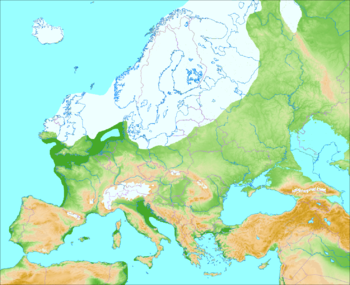They didn't evolve light skin, they married Nordics.
Really. When was that?
" Prehistoric Britain
The earliest evidence of human occupation around 900,000 years ago is at Happisburgh on the Norfolk coast, with stone tools and footprints probably made by Homo antecessor. The oldest human fossils, around 500,000 years old, are of Homo heidelbergensis at Boxgrove in Sussex. Until this time Britain was permanently connected to the Continent by a chalk ridge between south-east England and north-east France called the Weald-Artois Anticline, but during the Anglian Glaciation around 425,000 years ago a megaflood broke through the ridge, creating the English Channel, and after that Britain became an island when sea levels rose during interglacials. Fossils of very early Neanderthals dating to around 400,000 years ago have been found at Swanscombe in Kent, and of classic Neanderthals about 225,000 years old at Pontnewydd in North Wales. Britain was unoccupied by humans between 180,000 and 60,000 years ago, when Neanderthals returned. By 40,000 years ago they had become extinct and modern humans had reached Britain. But even their occupations were brief and intermittent due to a climate which swung between low temperatures with a tundra habitat and severe ice ages which made Britain uninhabitable for long periods. The last of these, the Younger Dryas, ended around 11,700 years ago, and since then Britain has been continuously occupied.
Mesolithic people occupied Britain by around 11,000 BP, and it has been occupied ever since. By 8000 BC temperatures were higher than today, and birch woodlands spread rapidly, but there was a cold spell around 6,200 BC which lasted about 150 years. The plains of Doggerland were thought to have finally been submerged around 6500 to 6000 BC
In 1997, DNA analysis was carried out on a tooth of Cheddar Man, human remains dated to c. 7150 BC found in Gough's Cave at Cheddar Gorge. His Mitochondrial DNA (mtDNA) belonged to Haplogroup U5. Within modern European populations, U5 is now concentrated in North-East Europe, among members of the Sami people, Finns, and Estonians. This distribution and the age of the haplogroup, indicate that individuals belonging to U5 were among the first people to resettle Northern Europe, following the retreat of ice sheets from the Last Glacial Maximum, about 10,000 years ago. It has also been found in other Mesolithic remains in Germany, Lithuania, Poland, Portugal, Russia, Sweden, France and Spain. Members of U5 may have been one of the most common haplogroups in Europe, before the spread of agriculture from the Middle East."
Source:Wikipedia
.



